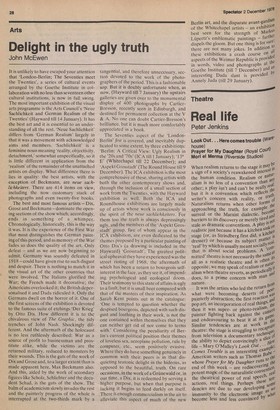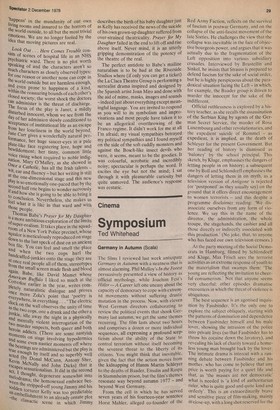Theatre
Real life
Peter Jenkins
Look Out . . . Here comes trouble (018rePrayer for My Daughter (Royal Court) house) Mod el Merma (Riverside Studios) When realism returns to the stage it Mg b.e a sign of a society's reawakened interest 111 the human condition. Realism or i natur; alism s no less of a convention than 01 other; a play isn't and can't be really rer i but t is a convention which reflects ibe writer's concern with reality, or truth./ Naturalism returns when other forins approaching the truth, for example ti`ce , surreal or the Marxist dialectic, beeollid barriers to its discovery or merely tired at stale as dramatic conventions. A play i5 realistic just because it has a kitchen sink% stage (or, as Strindberg first did, a kitcheis dresser) or because its subject matter ,4 'real' b. y which is usually meant socially re': that is about social problems. A 'C0/111At mitted' theatre is not necessarily the salne.'"t5 all asa realistic theatre and is often Ir., opposite; we may speak of realism or natait alism when theatre reverts, as periodieallYfiri does, to a prime concern with mall was the artists who led the return fr°g1t, nature. w what were becoming deserts a Pts painterly abstraction; the first reaction pop art, an incorporation of real things, Iv then it was superor photo-realign' ra painter fighting back against the cantee. and endeavouring to beat it at its garathe Similar tendencies are at work in e theatre: the stage is struggling to recaet—e, from television a documentary techn.14aof the ability to depict convincingly a shcae,re life — Mary O'Malley's Look Out . • le; Comes Trouble is an interesting exart American writers such as Thomas 133'he whose Prayer for My Daughter runs to the end of this week — are rediscovering the end magic of the naturalistic conventg3a1 the theatrical power of real speech' irten' actions, real things. Perhaps these 'oe dencies are due to our developing 5° vie immunity to the electronic image as bat become less and less convinced bY w 'happens' in the mundanity of our own living rooms and innured to the horrors of the world outside, to all but the most trivial etnotions. We are no longer fooled by the idea that moving pictures are real.
Look Out. . . Here Comes Trouble consists of scenes of hospital life in an NHS psychiatric ward. There is no plot worth Speaking of and the characters aren't so much characters as closely observed types: for one reason or another none can cope in the world outside but are harmless enough, and even prone to happiness of a kind, Within the reassuring bounds of each other's Closed society; the worst shock the doctors can administer is the threat of discharge. The focus of the play is Janet, a mildly disturbed innocent, whom we see from the• day of her admission slowly conditioned to acceptance of institutional life as an escape from her loneliness in the world beyond. Jane Carr gives a wonderfully natural performance, her huge saucer-eyes in a pale Plate-like face registering love, hope and bewilderment; her tinny, common little voice rising when required to noble indignation. Mary O'Malley, as she showed in °nce a Catholic, has all the Irish talents.– 'wit, ear and fluency – but her writing is still at the one-dimensional stage and this new Play is so emotionally one-paced that by the se. cond half one begins to wonder nervously if and how she is going to be able to bring it to conclusion. Nevertheless, she makes us feel what it is like in that ward and with those people. Thomas Babe's Prayer for My Daughter Is a more ambitious exploration of the limits Of super-realism. It takes place in the squadroom of a New York Police precinct, whose squalor is meticulously reproduced on stage down to the last speck of dust on an ancient box file. You can feel and smell the place and when the two cops hurl the handcuffed-junkies onto the stage they are at once real people all of them, stereotypes from the small screen made flesh and blood again. Babe, like David Mamet whose it_inerkan Buffalo I liked so much at the Lottesloe earlier in the year, writes completely naturalistic dialogue and Proves once more Zola's point that 'poetry is everywhere, in everything. . . 'The electric clock on as the wall observes the unity of time the two cops, one a drunk and the other a Junkie, idle away the night in a physically nd mentally violent interrogation of the Iwo murder suspects, both queer and both heroin addicts. (There are some nastyish 111_ nments on stage involving hypodermics 1,111d some even nastier moments off where tr e beatings are administered but the Play is Ile C enough by itself and so superbly well d_ted. (by Donal McCann, Antony Sher, etCevin McNally and John Dicks) that it ascapes sensationalism. It did in the second ct, I thought, degenerate somewhat into Melodrama; the homosexual embrace betWseeen the stripped-off young Jimmy and his dden torturer Kelly was too predictable !". embellishment to an already ornate plot nie climactic scene in which Jimmy describes the birth of his baby daughter just as Kelly has received the news of the suicide of his own grown-up daughter suffered from over-strained theatricality. Prayer for My Daughter failed in the end to lift off and rise above itself. Never mind, it is an utterly gripping demonstration of the potency of the theatre of the real.
The perfect antidote to Babe's mailine naturalism is to be had at the Riverside Studios where (if only you can get a ticket) the La Claca Theatre Group is performing a surrealist drama inspired and designed by the Spanish artist Joan Miro and done with the aid of mime, masks, images and sounds –indeed just about everything except meaningful language. You are invited to respond as you will to its symbolism and improvisations and most people have taken it to be an allegorical overthrowing of the Franco regime. It didn't work for me at all I'm afraid; my visual sympathies betrayed my political sympathies and I found myself on the side of the soft cuddly monsters and against the Bosch-like insect devils who were, it seems, meant to be the goodies. It was colourful, acrobatic and incredibly noisy; spectacular is perhaps the word. It excites the eye but not the mind; I sat through it with pleasurable curiosity but quite unmoved. The audience's response was ecstatic.







































 Previous page
Previous page